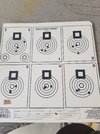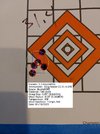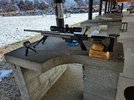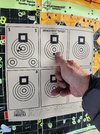I'm an old analog bastage...
I still measure groups with a caliper. If I want something real close to true center to center, I measure a couple lone bullet holes to determine paper stretch. A .224 bullet never makes a .224 hole. Paper almost always stretches at least a little. I usually use targets I printed out on the cheapest paper on the shelf and depending on humidity and such, the stretch can be quite a damn bit. I can see the app you use takes care of all that automagically

. I like my calipers though.
This was a first range session scanning, on my .20 Dasher mongrel parts rifle build.
You'll see, I'm not even bothering to try and get a C-T-C measurement. I'm just scanning, all I really care about is how these groups compare to each other, so outside to outside is quick and dirty and good enough. The two top groups are three shots, but the two bottom are four shots, even though, bottom right looks like three - one of them just went though the same hole as another though.
When things are really humming on a really accurate barrel, you have to make a lone hole to measure for stretch on purpose. The rest of them are just printing bugholes.
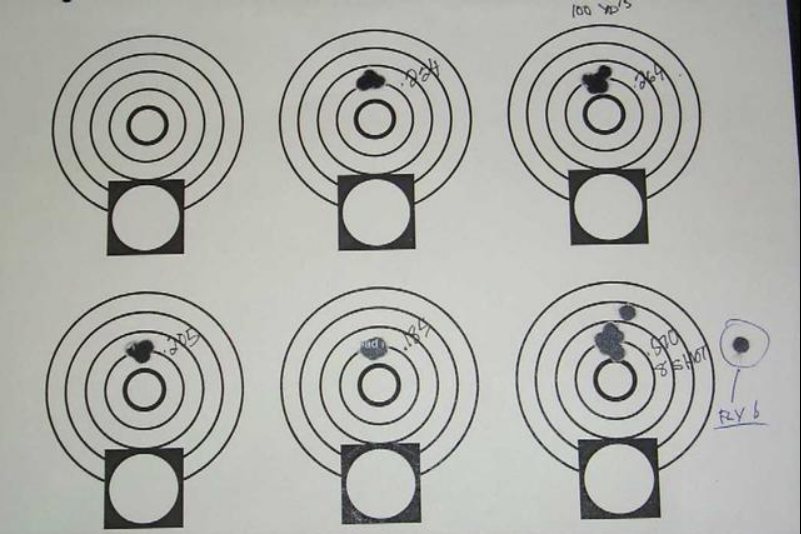
Those are four each, five shot groups (with two different loads, I chose the bottom one for a working load). The bottom right mothball isn't actually a "group". I was using that mothball as a sighter to check conditions before putting a bullet into the group I was working. I measured it anyway, as my aim point was the same on all those shots and I was interested in what that came up as. Compared to my groups where if the sighter landed one side of the line, I held the other side of the line for group - or waited for the wind flags to lay down again. This shows what even a very light breeze can do to groups - the wind was barely moving that day. I attributed the vertical in it to mirage off the barrel (despite a barrel length mirage shield) and also held off for that in the groups. Oh, and I had to make lone hole to measure paper stretch. so those are fly guts around the lone bullet hole, lol!
For dope, well, I'm pretty lame... Again, I'm a short ranger. Dope isn't very critical for what I do. If I can get the vertical right on a 500 yard shot from a clean cold barrel and then again later from the same barrel when it's hot and dirty, I'm happy as a clam. But, back in the long ago time when I flirted with long range for a couple of years, a desktop windows app from Sierra was state of the art and that's what I used for everything, for a long time. For quite a few years now though, I have relied on the JBM Ballistics website (for free). It does a lot more than that old Sierra program did. I don't run dope in the field or at the range. I print old fashioned dope cards and if I really always want it with me I tape the card to the stock. But usually just carry them in the MTM ammo boxes with the ammo.
Load data has always been huge to me. At some point about 15-20 years ago I switched to putting all my load data in spreadsheets. But a good portion of all my data is still in the old Sinclair Int'l data log books I used for many a year before Excel. I've always been 100% data driven for load tuning though. Even when I very first started out as a child. I used to use colored markers on graph paper to plot graphs of my A/B load tests when I was a kid.
This was from working load testing with my .17 Predator using then brand new to the market "new" Lapua Match .223 brass (I used to get pre-production samples of all new Lapua brass, my buddy Steve was the US distributor...). I kept load work super short and sweet on this one as it's a hot rod barrel burning sumbich. But what you are looking at is a ten shot group fired with a single piece of brass. That's typically how I do a final pressure check. If a primer pocket is still tight at "however many" loads (acceptable to me varies greatly with application...), I call pressure good to go. I put a lot of work into prepping my brass and I HATE losing any. Whether by dropping and can't find, or loosening up a primer pocket before it's time from a warm load.

Here's a ladder test on a point blank range prairie dog load for my first .22BR. Fired at 300 yards. I was testing 50 Vmax vs. 50 B-tip. Every shot a different powder charge. I just turned the target over between tests. You can see the Vmax totally smoked the B-tip load for vertical in this test with this powder (H4895). With the Vmax, 11 shots with 11 different powder charges at 300 yards printed a 1.25" (.4 MOA) group. With some really nice load clumps. That's the bottom load, from the one holer tuning session posted above.
As I said earlier, I have always liked the ladder test for definitively beginning to sort the pepper from the fly shit. When I first learned of it, it was called the Audette method. Named after Creighton Audette. He used to write some killer tech for Precision Shooting magazine, way, way back in the day.
- DAA
